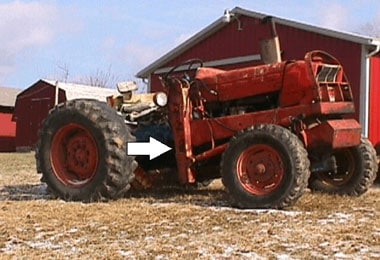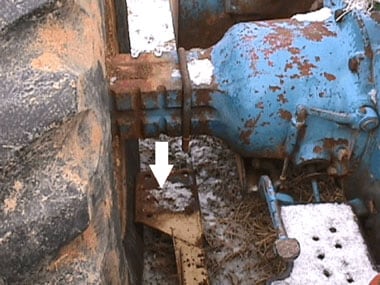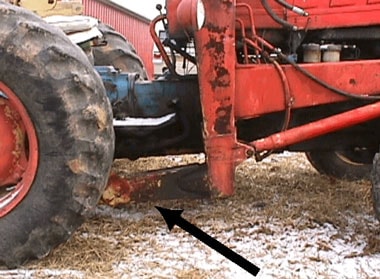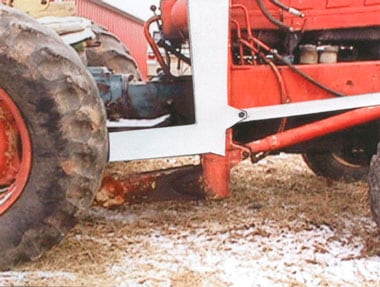Tractor Owner Dies After Being Pinned by Tractor Attachment Which Fell on Him During Disassembly in West Virginia
Case: 03WV044-01
Release Date: March 7, 2004
SUMMARY
On December 28, 2003, a 79-year-old male tractor owner (victim) died of injuries sustained when the tractor component he was removing fell on him fatally pinning him to the ground. While the victim was in the process of removing the tractor’s front-end loader, he had positioned himself under the rear part of the attachment without supporting it. Upon removing the last nut which anchored the attachment to the bottom of the tractor’s rear axle, the component dropped to within 6-8 inches of the ground compressing the victim’s chest. The victim’s wife came out to check on her husband and found him pinned under the component. She called EMS, which arrived shortly thereafter, and found no signs of life. The body was extricated and transported to the local funeral home.
The WV FACE investigator concluded that to reduce the likelihood of similar occurrences, the following guidelines should be observed by tractor owners and equipment mechanics:
- Ensure that prior to inspecting, adjusting, repairing, or removing elevated components, a strong positive means of support be used before placing any part of the body under an elevated load.
INTRODUCTION
On January 5, 2004, the WV FACE Program was notified by a newspaper clipping service that a tractor-related death had occurred on December 28, 2003. The field investigator traveled to the site on January 15, 2004 and met with the county coroner to discuss the incident. Photographs and measurements were taken of the piece of equipment and incident site. The victim’s widow was interviewed. The death certificate and related newspaper articles were also obtained and reviewed.
The victim was a mechanic who owned 306 acres yielding hay which was sold each year.
He had owned, operated, and maintained the tractor involved in the incident for the past 22 years. It was reported that he was an experienced and careful mechanic who always supported and cribbed elevated loads during maintenance and repair.
INVESTIGATION
On December 28, 2003, a 79-year-old male tractor owner (victim) died of injuries sustained when the tractor component he was removing fell on him fatally pinning him to the ground. The victim was in the process of removing the tractor’s front-end loader in order to replace it with a newer one (see Figure1). At the time of the incident, the victim was unbolting the rear points of attachment which where located under the left and right rear axles (see Figure 2). He had first removed all of the nuts on the left side, and was in the process of removing the last nut on the right side. He had positioned himself under the right rear part of the attachment without supporting it (see Figure 3). Upon removing the nut which anchored the attachment to the bottom of the tractor’s right rear axle, the component, being supported solely by the front of the tractor, dropped to within 6-8 inches of the ground compressing the victim’s chest (see Figure 4). The victim’s wife came out to check on her husband and found him pinned under the component. She called EMS, which arrived shortly thereafter and found no signs of life. The body was extricated and transported to the local funeral home.
CAUSE OF DEATH
The cause of death was listed as compression asphyxia as well as chest trauma.
RECOMMENDATIONS/DISCUSSION
Recommendation #1: Tractor owners and equipment mechanics should ensure that prior to inspecting, adjusting, repairing, or removing elevated components, a strong positive means of support be used before placing any part of the body under an elevated load.
Discussion: In this incident, the victim was working under an elevated load which was unsupported. It is unclear why the victim chose not to block or support the component as it was reported he had done in very similar situations in the past. Correctly chocking or blocking the attachment on both sides with timber or jack-stands prior to removing any of the nuts would have prevented this incident by supporting and/or arresting the energy source before contacting the victim.
ILLUSTRATIONS

|
|
Figure l. The arrow points to the component being removed at the time of the incident.
|

|
|
Figure 2. Photo shows the right rear attachment point. Arrow points to component which fell.
|

|
|
Figure 3. The arrow represents the victims position while removing the last nut located under the right rear axle. He was on his back with his chest directly below the component identified by the arrow.
|
 |
|
Figure 4. The white silhouette represents the component’s original position prior to dropping to within 6-8 inches of the ground pinning the victim.
|
FATALITY ASSESSMENT AND CONTROL EVALUATION PROGRAM
The WVU Center for Rural Emergency Medicine, through a contract with the West Virginia Department of Health and Human Resources and Bureau for Public Health, conducts investigations on the causes of work-related fatalities within the state. The goal of this program is to prevent future fatal workplace injuries. West Virginia FACE intends to achieve this goal by identifying and studying the risk factors that contribute to workplace fatalities, by recommending intervention strategies, and by disseminating prevention information to employers, employees, trade associations, unions, equipment manufacturers, students, teachers, and others with an interest in workplace safety.
Please use information listed on the Contact Sheet on the NIOSH FACE website to contact In-house FACE program personnel regarding In-house FACE reports and to gain assistance when State-FACE program personnel cannot be reached.
